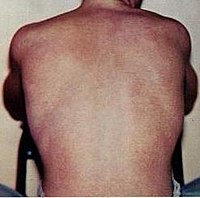
Photo from wikipedia
Environmental changes are among the main factors that contribute to the emergence or re-emergence of viruses of public health importance. Here, we show the impact of environmental modifications on cases… Click to show full abstract
Environmental changes are among the main factors that contribute to the emergence or re-emergence of viruses of public health importance. Here, we show the impact of environmental modifications on cases of infections by the dengue, chikungunya and Zika viruses in humans in the state of Tocantins, Brazil, between the years 2010 and 2019. We conducted a descriptive and principal component analysis (PCA) to explore the main trends in environmental modifications and in the cases of human infections caused by these arboviruses in Tocantins. Our analysis demonstrated that the occurrence of El Niño, deforestation in the Cerrado and maximum temperatures had correlations with the cases of infections by the Zika virus between 2014 and 2016. El Niño, followed by La Niña, a gradual increase in precipitation and the maximum temperature observed between 2015 and 2017 were shown to have contributed to the infections by the chikungunya virus. La Niña and precipitation were associated with infections by the dengue virus between 2010 and 2012 and El Niño contributed to the 2019 outbreak observed within the state. By PCA, deforestation, temperatures and El Niño were the most important variables related to cases of dengue in humans. We conclude from this analysis that environmental changes (deforestation and climate change) presented a strong influence on the human infections caused by the dengue, chikungunya and Zika viruses in Tocantins from 2010 to 2019.
Journal Title: International Journal of Environmental Research and Public Health
Year Published: 2022
Link to full text (if available)
Share on Social Media: Sign Up to like & get
recommendations!